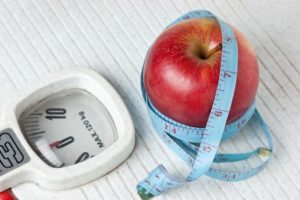What Can You Do If You Think You Are Overweight?
When considering if you are overweight or not, there is another question you should address.  Are you healthy? Too many times people focus on the wrong measurements regarding their health. Two people can be the exact same height and weigh the exact same amount. They can look basically the same in body composition, but one may be extremely healthy, while the other is knocking on death’s door.
Are you healthy? Too many times people focus on the wrong measurements regarding their health. Two people can be the exact same height and weigh the exact same amount. They can look basically the same in body composition, but one may be extremely healthy, while the other is knocking on death’s door.
So, what is the big deal about carrying around an extra few pounds if you feel good about yourself and are relatively healthy? The problem is what may be happening inside you. When you are overweight, your body is out of alignment. This causes your internal systems to work in a way they were not intended to. Accordingly, if you are overweight or obese, you are at a heightened risk level for heart disease, stroke, diabetes, neurological conditions like Parkinson’s and Alzheimer’s and shortened life span.
How Do You Know If You Are Overweight?
If you’re thinking “Am I overweight?”, it’s not always obvious. Finding extremely accurate ways of measuring your level of health, as it relates to your weight, musculature and fat stores, begins with understanding what the terms “overweight” and “obese” really mean.
“Overweight” Defined
The Mayo Clinic tells us that “… being overweight or obese are both labels for ranges of weight that are greater than what is generally considered healthy for a particular height.”
Furthermore, if your weight is 10% to 20% higher than what is considered normal and healthy for your height, you register as overweight. If you’re more than 20% above the normal weight for how tall you are, you can consider yourself obese.
What Is Considered Obese For A Woman Or Man?
Health institutions will tell you that if your body mass index (BMI) falls between 25 and 29.9, you’re considered overweight. Any BMI measurement of 30 or greater is a sign of obesity. But the BMI measuring stick has come under a lot of heat over recent years. That’s because it doesn’t take into account several features of individual body composition that can produce an inaccurate result.
BMI doesn’t measure amounts of body fat. It simply tells you your “correlation of body fat to body mass/height“, as compared to all other human beings your age, size and gender.
It doesn’t take into account what portion of your body is fat, and what portion is made up of muscle. Muscle weighs more than fat, so muscular people, even though they may have less fat than others, can show inflated BMI scores.
Free Report: Top 5 Exercise Mistakes
Are You Healthy, Overweight or Obese?
The key to finding out whether you are healthy, overweight or obese, is to find out how much body fat you have. Do you have more fat than muscle? Can you pinch layers of fat on different parts of your body? Do you have prominent amounts of fat where fat is hard to collect, like around your ankles and wrists?
Many respected health authorities are moving away from relying solely on BMI to measure weight. BMI can be a good indicator of a problem. However, there are some other ways to measure whether you are overweight, obese or unhealthy that doctors and medical institutions believe are more accurate.
Dual Energy X-Ray Absorptiometry
Electrodes are placed under each of your feet. Micro-electrical impulses move up through your body. How long it takes these impulses to return back to the measuring device is calculated. This body mass measurement relies on the fact that lean muscle tissue transfers electrical impulses faster than fat tissue. This provides a very accurate measurement.
Skin Calipers
Because muscle is 4 times more dense than fat, skin calipers are believed to be a better measurement of whether you are overweight, underweight, normal or obese. Sections of fat around your body are measured. This is done by using a simple plier-shaped tool, measuring the amount of fat on your thighs, your back, your chest, your abdominals, your arms, etc.
Hydrostatic Measurements
Hydrostatic weighing, also called underwater displaced weight, compares your weight outside of water to your weight in water. This is considered one of the most accurate assessments of weight versus health, and it is considered the standard for clinical research.
Air Displacement Plethysmography
Like the water displacement measurement above, this weight measure method is extremely accurate. You are placed in a small machine that looks like a pod. Using air displacement measurement, technicians measure and record how much air is pushed out of the machine when you enter it. The air before and after you entered the pod is used, along with air density calculations, to calculate your body composition. The problem here is access. Most doctor’s offices and even many hospitals do not usually have one of these machines.
Simple Tape Measure
Yes, you can calculate whether you are overweight or obese right at home. Follow this easy to remember formula:
- Your waist circumference should be equal to or less than half your height.
If you’re 5 feet tall (60 inches), your waist should be 30 inches or smaller. If you’re 6 feet tall (72 inches), ideally your waist should measure 36 inches around, or smaller. Excessive fat tends to group around your waist and stomach, and that fact is the basis for this “overweight versus not overweight” measurement.
Bear in mind that this simple calculation does not take into account musculature and body composition. But can give you an idea of whether you are at a healthy weight, as opposed to overweight or obese.
Weight Measurement Scales
Of course, there are always a simple weight measurement scales that people often have in their bathroom at home. You can also use scales to see if your weight is fluctuating as well. Once again, the problem lies in the fact that muscle is much heavier than fat. Simple weight measurement scales should never be used as the only tool for calculating whether you are healthy, overweight or obese. Used in conjunction with the more accurate tools listed above however, you can get a better picture of your true body composition.
Less Obvious Signs That You Are Overweight
Sometimes trying to figure out if you are overweight is not so simple. If you use several of the methods listed above you will have a very clear picture of whether you need to gain muscle, lose fat or both. Health professionals agree that these are extremely accurate for defining your body composition. However, you may not be able to access those accurate body composition measuring tools. If that is the case, and you are still unsure if you have a weight problem, look for the following less than obvious symptoms of an unhealthy weight.
- You find exercise difficult
- You drink lots of sodas, soft drinks and energy drinks
- All the processed food you eat is labeled “fat-free” (usually meaning high levels of unhealthy sugar)
- You’re tired and out of breath after walking a flight of stairs
- Your pants are tight at the waist
- You experience chronic fatigue
- You have high blood pressure and/or cholesterol
- Common, daily activities wear you down
- A friend or family member has commented about your weight gain
- You have excessive fat around your neck, hips or upper arms
- Your feet are constantly sore
- Painful knees
- Heartburn
What Can You Do If You Are Overweight?
Take a hard look at your diet and workout plan as well as your calorie-tracking system to ensure everything is on the right track. Take advantage of apps like My Food Diary. This highly-acclaimed food database contains over 100,000 foods to improve your diet and the exercise log can calculate calories burned for over 700 activities to help you achieve your weight loss goal.

